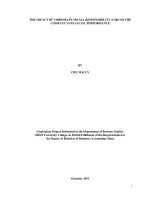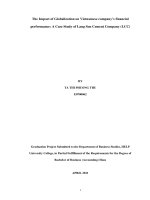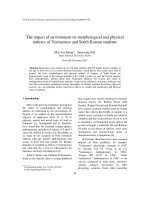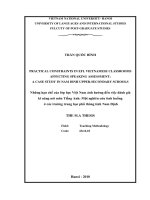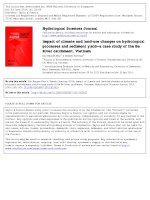the impact of globalization on vietnamese company’s financial performance a case study of lang son cement company (lcc)
Bạn đang xem bản rút gọn của tài liệu. Xem và tải ngay bản đầy đủ của tài liệu tại đây (515.88 KB, 47 trang )
i
The Impact of Globalization on Vietnamese company’s financial
performance: A Case Study of Lang Son Cement Company (LCC)
BY
TA THI PHUONG THU
E0700062
Graduation Project Submitted to the Department of Business Studies, HELP
University College, in Partial Fulfillment of the Requirements for the Degree of
Bachelor of Business (Accounting) Hons
APRIL 2011
ii
Declaration of Originality and Word Count
DECLARATION
I here by declare that this graduation project is based on my original work except for
quotations and citation which have been duly acknowledged. I also declare that it has
not been previously or concurrently submitted for any other courses/degrees at HELP
University College or other institutions. The word Count is 10,007 words.
TA THI PHUONG THU
28 March, 2011
iii
Acknowledgement
This project would not have been made possible without the assistance, support and
encouragement of many people. I wish to take this opportunity to thank all the people
who have helped me during the time of completing the dissertation.
Firstly, I would like to express my deep gratitude to my supervisor Dr. Dao Thi Thu
Giang at the Foreign Trade University (FTU) of Viet Nam . SHe has kindly helped
me and supported me all the way through. For that, I am very grateful. I also would
like to express my thank to Ms. Sumathi at Help University College, who initiated
the project and give so much instruction and support.
TA THI PHUONG THU
iv
Abstract
THE IMPACT OF GLOBALIZATION ON VIETNAMESE
COMPANY’S FINANCIAL PERFORMANCE: A CASE STUDY
OF LANG SON CEMENT COMPANY (LCC)
BY
TA THI PHUONG THU
March 2011
Supervisor: Dr. Dao Thi Thu Giang
Globalization is not new trend in the world but is still new in Vietnam. Vietnam is
one of the developing countries, so the impact of globalization on Vietnam‟s
economy has many things to discuss. The objective of the research is to assess the
understanding of globalization trend and its effect on Vietnamese company‟s
financial activities. Besides, the research also wants to show the role of the financial
analysis in its investment strategies and good financial planning of the board of
management. In this research, Lang Son Cement Company is taken as a typical case
study that goes through my study.
v
TABLE OF CONTENT
Declaration of Originality and Word Count……………………………………… ii
DECLARATION……………………………………………………………………ii
Acknowledgement………………………………………………………………… iii
Abtract……………………………………………………………………………….iv
TABLE CONTENT………………………………………………………………….v
LIST OF FIGURES AND TABLES………………………………………………vii
LIST OF ABBREVIATIONS…………………………………………………… viii
CHAPTER 1: INTRODUCTION………………………………………………….1
1.1 Introduction…………………………………………………………… 2
1.2 Need for research………………………………………………………… 3
1.3 Elements of the research……………………………………………………3
1.4 Scope of research……………………………………………………………3
1.5 Assumptions…………………………………………………………………4
1.6 Plan of presentation…………………………………………………………4
CHAPTER 2: LITERATURE REVIEW………………………………………… 5
2.1 A general look at financial statement………………………………………6
2.2 The general approach applied in analysis of financial statement……… 7
2.3 The nature of globalization……………………………………………… 17
2.4 The impact of globalization on the financial performance of
Vietnamese’s company; a typical example is LCC’s financial performance… 18
CHAPTER III: RESEARCH METHODOLOGY……………………………….20
3.1 Research objective…………………………………………………………21
3.2 Research strategy………………………………………………………… 21
3.3 Research hypothesis……………………………………………………… 21
3.4 Research methodology…………………………………………………… 26
3.5 Data sources and sampling……………………………………………… 26
3.6 Limitation of research 27
CHAPTER IV: ANALYSIS……………………………………………………….28
4.1 Results Analysis…………………………………………………………….29
4.2 Discussion………………………………………………………………… 34
vi
CHAPTER 5: CONCLUSION…………………………………………………….36
5.1 Implication of research…………………………………………………….36
5.2 Conclusion………………………………………………………………….36
Bibliography……………………………………………………………………… 38
Appendices………………………………………………………………………….39
vii
LIST OF FIGURES AND TABLES
Figure 1. The Du Pont system of financial analysis model 26
Table 1 : The liquidity ratio 31
Table 2 : Asset – Management ratios 33
Table 3 : Financial – leverage ratios 35
Table 4 : Profitability ratios 36
viii
LIST OF ABBREVIATIONS
LCC Lang Son Cement Company
WTO World Trade Organization
BEP Breakeven point
1
CHAPTER I: INTRODUCTION
1.1 Introduction
1.2 Need for Research
1.3 Elements of the Research
1.4 Scope of Research
1.5 Assumptions
1.6 Plan of Presentation
2
1.1 – Introduction
To begin my task, I will talk about the meaning of globalization. Globalization is
considered as “a process of interaction and integration among the people, companies,
and governments of different nations, a process driven by international trade and
investment and aided by information technology. This process has effects on the
environment, on culture, on political systems, on economic development and
prosperity, and on human physical well-being in societies around the world.”
1
Globalization has a strong effect on the Vietnamese company‟s financial
performance. As you can see, companies should prepare their annual financial
statements in order to measure the benefit rate after each financial year. Reviewing
and assessing financial information bring about an understanding of a company‟s
strengths and weaknesses, how its annual plan has been carried out and what
investment effect level its plan implementation results in. This activity will make an
impact on its investment strategies and good financial planning.
As can be seen, the financial statement of a company is based on financial facts but
can be influenced by its management and may cause misstatements or fraud in them.
Therefore, the purpose of this paper is to revise and reanalyze the 2007 and 2008
financial statements of Lang Son Cement Company (LCC) in order to assess and
make a comparison of financial activities between 2007 and 2008. From this analysis
of financial statements, suggestions and proposals about investment, financial
statements can be submitted to LCC to have an improvement of financial statement
preparation.
1
3
1.2 Need for research
Today, the competitive world of business is so high; the analysis of a financial
statement takes an important role in business activities of a company. Because any
company also need an improvement of financial statement preparation to attract the
investments from other investors or cooperation from other companies. Moreover,
the business results are also reviewed and assessed to show the positive and negative
aspects in financial situation. This research‟s purpose is to provide the better
information to managers that can help them to understand the overall the positive
indirect impact of globalization on Vietnamese‟s financial statement in general and
impact on the financial situation of Lang Son Cement Company (LCC) in particular.
1.3 Elements of the research
1.3.1 Research question
How can globalization affect on the Vietnamese company in general and LCC in
particular? How financial statements of LCC have been prepared? And does
investment results in benefit?
1.4 Scope of research
The scope of this thesis is to reanalyze and to identify frauds and misstatements
which are normally caused in financial statement preparation in a company.
In the context of economic globalization and crisis in the past few years, companies
in Vietnam meet multiple challenges; they prove their business activities to be
productive and beneficial, survive in global crisis. LCC also suffers these influences
4
and still survive. The question of whether or not a financial support from the
government has been provided or LCC has saved itself needs to be investigated.
1.5 Assumptions
Globalization is the great trend of economy in all over the world. It takes an
important role in the economy development in almost countries in the world. In my
task, I will give the details of financial statement analysis and the impact of
globalization on financial activities in Vietnam in general and in LCC in particular.
1.6 Plan of presentation
My research is organized in five chapters. In chapter II, the literature will be
reviewed on the general look at financial statement, the general approach applied in
analysis of financial statements, the nature of globalization, and the impact of
globalization on the financial statement of Vietnamese‟s company; a typical example
is LCC‟s financial statement. Then, in chapter III, I present methodology that shows
the description of my research data, hypothesis, variables‟ measurement and
limitations. Next, in chapter IV, I analyze results of the statistical estimation, and a
discussion. Finally, in chapter V, I summarize my findings and the study implications
for future research.
5
CHAPTER II: LITERATURE REVIEW
2.1 A general look at financial statements
2.2 The general approach applied in analysis of financial statements
2.3 The nature of globalization
2.4 The impact of globalization on the financial performance of Vietnamese‟s
company; a typical example is LCC‟s financial performance
6
2.1 A general look at financial statement
Financial statement is one of the most important things in running business because it
shows the last business results in each company. In traditional view, “financial
statements are summaries of monetary data about an enterprise. The most common
financial statements include the balance sheet, the income statement, the statement of
changes of financial position and the statement of retained earnings. These
statements are used by management, labor, investors, creditors and government
regulatory agencies, primarily. Financial statements may be drawn up for private
individuals, non-profit organizations, retailers, wholesalers, manufacturers and
service industries. The nature of the enterprise involved dramatically affects the kind
of data available in the financial statements. The purposes of the user dramatically
affect the data he or she will seek.”
2
In new economy, financial statement can be
considered as “Financial statements can organize accounting data to facilitate
decision-making by management and by investors. The way financial data is
presented for such decisions may be quite different from the way data is presented to
fulfill legal requirements that satisfy tax authorities and other regulators. Thus,
companies have increasingly produced more than one financial statement, each
intended for a different audience. The "pro forma" financial statements which
emerged from the bull market of the 1990s are the most notable example of an
investor-directed statement.”
3
2
3
7
2.2 The general approach applied in analysis of financial statements
The general approach applied in analysis of financial statements will be used in this
thesis, presented as follow:
2.2.1 Ratio analysis: is a financial technique that involves dividing various financial
statement numbers into another
Ratios are computed by dividing one number or data on the financial statements into
another. And the results of these calculations are percentages. Ratio analyses permit
the manager of the company to determine business trends and compare its ratios to
average ratio of similar businesses in the same industry. Ratios are important devices
because “they standardize balance sheet and income statement.”
4
2.2.1.1. Trend or time series analysis: uses ratios to evaluate a firm‟s
performance over time. It concerns the analysis of data collected over time weekly
values, monthly values, quarterly values, yearly values, and so on. The intention is
usually to differentiate whether there is some patterns in the values collected to date,
with the intention of short term forecasting (to use as the basis of business
decisions).
5
We will write:
Yt = response of interest at time t
Standard analysis of business time series involves smoothing trend assessment,
assessment of accounting for seasonality, and assessment of exploiting serial
correlation.
2.2.1.2. Cross – section analysis uses ratios to compare different companies at
the same point in time.
4
5
Resources from
8
It can be defined as “A type of analysis an investor, analyst or portfolio manager may
conduct on a company in relation to that company's industry or industry peers. The
analysis compares one company against the industry it operates within, or directly
against certain competitors within the same industry, in an attempt to discover the
best of the breed.”
6
2.2.1.3. Industry – comparative analysis is used to compare a firm‟s ratios
against average ratios for other companies in the same industry.
Industry – comparative analysis can be considered as “Just as important as trend
analysis is industry analysis. It's very important, particularly in today's economic
climate, to know what your industry is doing as compared to your company. For
example, if your industries ratios are much different than your firms, you want to
examine why and perhaps take action.”
7
2.2.2 Types of financial ratios
There are many types of ratios which can be calculated from financial statement data;
however, it can be grouped in five main categories such as liquidity ratios, asset –
management ratio, financial – leverage ratio, profitability ratio, and market – value
ratio. They will be illustrated in the following paragraphs.
2.2.2.1. Liquidity ratios:
a. Liquidity refers to how quickly a firm can turn its assets into cash.
Liquidity ratios indicate the ability to meet short – term obligations to creditors as
they mature or come due. Any firm must have responsibility to pay financial
obligations when needed. If they cannot pay financial requirement, they will be
6
7
9
bankrupted. Almost firms want to convert assets into cash with little or no loss in
value
b. The net working capital of a firm is its current assets minus current
liabilities
Year 2007:
The net working capital: 29,886,328.339 - 25,430,762.984 = 4,455,565.35(VND)
Year 2008:
The net working capital: 31,664,296.641 – 28,248,834.480 = 3,415,462.16(VND)
c. The current ratio is a measure of a company‟s ability to pay off its short
– term debt as it comes due. The current ratio is one of the best known measures of
the financial strength. It can be calculated as:
Current ratio = current assets / current liabilities
Year 2007: current ratio: 29,886,328.339 / 25,430,762.984 = 1,175.2 (VND)
Year 2008: current ratio: 31,664,296.641 / 28,248,834.480 = 1.1209 (VND)
d. The quick ratio, or acid – test ratio is compared by dividing the sum of
cash, marketable securities, and accounts receivable by the current liabilities.
Quick ratio =
liabilitycurrent
receivable accounts cash
Year 2007: quick ratio:
984.762,430,25
378.593,914,8994.463,601,1
0.4135 times
Year 2008: quick ratio:
380.834,248,28
111.893,344,9817.015,247,10
0.69 times
e. The average payment period is compared by dividing the year – end
accounts payable amount by the firms average cost of goods sold per day
Average payment period =
365 / sold good ofcost
payable accounts
=
dayper sold good ofcost
payable accounts
10
Year 2007: average payment period:
365/784.268,919,62
283.716,473,1
8.5 per day
Year 2008: average payment period:
365/692.544,009,107
417.773,331,1
4.5 per day
2.2.2.2 Asset – management ratios: indicate the extent to which assets are
used to support sales. These are sometimes referred to as activity or utilization ratios,
and each ratio in this category relates financial performance on the income statement
with items on the balance sheet.
a. The total – assets – turnover ratio is compared by dividing net sales
by the company‟s total assets
Total assets turnover =
assets total
salesNet
Year 2007: total assets turnover:
804.794,163,103
234.292,174,73
0.7 times
Year 2008: total assets turnover:
955.873,443,102
786.728,739,131
= 1.28 times
b. The fixed – assets – turnover ratio is compared by dividing net sales
by the fixed assets and indicates the extent to which long – term assets are being used
to produce sales
Fixed assets turnover =
assets fixed
salesnet
Year 2007: fixed assets turnover:
712.913,368,69
234.292,174,73
= 1.05 times
Year 2008: fixed assets turnover:
612.202,433,67
786.728,739,131
= 1.95 times
c. The average collection period is calculated by taking the year – end
accounts receivable divided by the average net sales per day
11
This indicates the average number of days that sales are outstanding. In other words,
it reports the number of days it takes, on average, to collect credit sales. The average
collection period measures the days of financing that a company extends to its
customers. Obviously, a shorter average collection period is usually preferred to a
longer one.
d. The receivable turnover is computed by dividing annual sales,
preferably credit sales, by the year – end accounts receivable
Average collection period =
365 / salesnet
receivableaccount
(account receivable/net sales per
day)
Year 2007: average collection period:
365/234.292,174,73
738.593,914,8
= 44.5 days
Year 2008: average collection period:
365/786.728,739,131
111.893,344,9
= 26 days
- The inventory turnover is computed by dividing the cost of goods sold by the year –
end inventory
Inventory turnover =
inventory
sold goods ofcost
Year 2007: inventory turnover:
537.852,327,12
784.268,919,62
= 5.1 times
Year 2008: inventory turnover:
879.894,851,11
692.544,009,107
= 9 times
Here we are looking for to determine how efficiently the amount of inventory is
being managed. With inventory management, it is careful to have an adequate
amount to avoid running out of products while avoiding the accumulation of too
many products that may require extra financing. The turnover ratio shows whether
12
the inventory is out of line in relation to the volume of sales when compared against
industry rules or when tracked over time for a detailed company.
2.2.2.3. Financial – leverage ratios
a. Financial – leverage ratios indicate the extent to which borrowed or debt
fund are used to finance assets
Total debt to total assets =
assets total
debt total
Year 2007: total debt to total assets:
804.794,163,103
231.525,188,61
= 0.593 = 59.3 %
Year 2008: total debt to total assets:
955.873.433,102
097.735,318,55
= 0.54 = 54 %
These ratios are also a good way to assess the ability of the firm to meet its debt
payment obligations. The total-debt-to-total-assets ratio is computed by dividing the
total debt or total liabilities of the business by its total assets. This ratio shows the
portion of the total assets financed by all creditors and debtors.
b. The total – debt – to – equity ratio shows a firm‟s total debt in relation
to the total dollar amount owners have invested in the firm
c. The equity – multiplier – ratio provides another way of looking at the
firm‟s debt burden
Equity multiplier =
equity total
assets total
Year 2007: equity multiple:
745.686,971,41
804.794,163,103
= 2.45
Year 2008: equity multiple:
605.655,153,47
955.873,433,102
= 2.17
13
d. The interest coverage or times – interest – earned ratio, is calculated by
dividing the firm‟s operating income or earnings before interest and taxes (EBIT) by
the annual interest expense.
Interest coverage =
expenseinterst
taxes&interest before earnings
Year 2007: interest coverage:
417.462,464,1
745.686,166,3
= 2.16 times
Year 2008: interest coverage:
049.736,296,10
987.207,521,4
= 0.43 times
The interest coverage figure indicates the extent to which the operating income or
EBIT level could decline before the ability to pay interest obligations would be
delayed. In addition to interest payments, there may be other fixed charges, such as
rental or lease payments and periodic bond principal repayments, the sinking fund
payments.
2.2.2.4. Profitability ratios: indicate the firm‟s ability to generate returns on its
sales, assets, and equity. Two basic profit margin ratios are important to the financial
manager, the operating profit margin and the net profit margin.
a. The operating profit margin is calculated on the firm‟s earnings before
interest and taxes divided by net sales. This ratio indicates the firm‟s ability to
control operating expenses relative to sales.
Operating profit margin =
salesnet
taxes&interest before earnings
Year 2008: operating profit margin:
234.292,174,73
745.686,166,3
= 0.043 = 4.3 %
Year 2007: operating profit margin:
786.728,739,131
897.207,521,4
= 0.034 = 3.4 %
14
b. The net profit margin: a widely used measure of a company‟s
profitability is calculated as the firm‟s net income after taxes divided by net sales.
Net profit margin =
salesnet
incomenet
Year 2008: net profit margin:
234.292,174,73
745.686,166,3
= 0.043 = 4.3 %
Year 2007: net profit margin:
786.728,739,131
605.655,348,4
= 0.033 = 3.3 %
In addition to considering operating expenses, this ratio also indicates the ability to
earn a return after meeting interest and tax obligations.
c. The operating return on assets is compared as the earnings before
interest and taxes divided by total assets. Notice that this ratio focuses on the firm‟s
operating performance and ignores how the firm is financed and taxed.
Operating return on assets =
assets total
taxes&interest before earnings
Year 2007: operating return on assets:
804.794,163,103
745.686,166,3
= 0.0306 = 3.1 %
Year 2008: operating return on assets:
955.873,433,102
897.207,521,4
= 0.044 = 4.4 %
d. The net return on total assets: commonly referred to as the return on
total assets, is measured as the firm‟s net income divided by total assets. Here we
measure the return on investment in assets after a firm has covered its operating
expenses, interest costs, and tax obligations.
Return on total assets =
assets total
incomenet
Year 2007: return on total assets:
804.794,163,103
745.686,166,3
= 0.0306 = 3.1 %
15
Year 2008: return on total assets:
955.873.433,102
605.655,348,4
= 0.042 = 4.2 %
e. The return on equity measures the return that shareholders earned on
their equity invested in the firm. The return on equity is measured as the firm‟s net
income divided by stockholders‟ equity. This ratio reflects the fact that a portion of a
firm‟s total assets are financed with borrowed funds.
Return on equity =
equitycommon
incomenet
Year 2007: return on equity:
745.686,971,41
745.686,166,3
= 0.075 = 7.5 %
Year 2008: return on equity:
605.655,153,47
605.655,348,4
= 0.092 = 9.2 %
2.2.2.5. Market – value ratios: indicates the willingness of investors to value a
firm in the marketplace relative to financial statement values.
A firm‟s profitability, risk, quality of management, and many other factors are
reflected in its stock and security prices by the efficient financial markets. Financial
statements are historical in nature, but the financial markets look to the future. We
know that stock prices seem to reflect much of the known information about a
company and are fairly good indicators of a company‟s true value. Hence, market
value ratios indicate the market‟s assessment of the value of the firm‟s securities.
a. The price/ earnings ratio, or P/E ratio, is simply the market price of the
firm‟s common stock divided by its annual earnings per share.
Sometimes called the earnings multiple, the P/E ratio shows how much investors are
willing to pay for each dollar of the firm‟s earnings per share. Earnings per share
come from the income statement, so it is sensitive to the many factors that affect net
income. Though earnings per share cannot reflect the value of the firm‟s patents or
16
assets, human resources, culture, quality of management, or its risk, stock prices can
and do reflect all these factors. Comparing a firm‟s P/E relative to that of the stock
market as a whole, or the firm‟s competitors, indicates the market‟s perceptions of
the true value of the company.
b. The price – to – book – value ratio measures the market‟s value of
the firm relative to balance sheet equity.
The book value of equity is simply the difference between the book values of assets
and liabilities appearing on the balance sheet. The price-to-book-value ratio is the
market price per share divided by the book value of equity per share. A higher ratio
suggests that investors are more optimistic about the market value of a firm‟s assets,
its intangible assets, and its managers‟ abilities.
Financial managers and analysts often talk about the quality of a firm‟s earnings or
the quality of its balance sheet. This has nothing to do with the size of a company‟s
earnings or assets or who audited the financial statements. Quality financial
statements are those that accurately reflect the firm‟s true economic condition. In
other words, accounting methods were not used to inflate its earnings or assets to
make the firm look stronger than it really is. Therefore, based on a quality income
statement, the company‟s sales revenues are likely to be repeated in the future.
Earnings are not affected by one-time charges. A quality balance sheet will represent
inventory that is marketable, not out of fashion or technologically obsolete. It will
represent limited debt, indicating the firm could easily borrow money should the
need arise. The firm‟s assets will have market values that exceed their accounting
book values; in other words, the firm‟s assets will not be inflated by intangible assets
such as “goodwill” or “patents.”
17
2.3 The nature of globalization
At the beginning, I will show the definition of globalization. Globalization is defined
as “the process by which regional economies, societies, and cultures have become
integrated through a global network of political ideas through communication,
transportation, and trade. The term is most closely associated with the term economic
globalization: the integration of national economies into the international economy
through trade, foreign direct investment, capital flows, migration, the spread of
technology, and military presence.”
8
In other definition, globalization is considered
as “the expansion of global linkages, the organization of social life on a global scale,
and the growth of a global consciousness, hence to the consolidation of world
society. Such an ecumenical definition captures much of what the term commonly
means, but its meaning is disputed. It encompasses several large processes;
definitions differ in what they emphasize. Globalization is historically complex;
definitions vary in the particular driving force they identify.”
9
Globalization is not a new trend because it has a long history process, for thousands
of years, people have been buying from and selling to each other in lands at large
distances, such as through the famed Silk Road across Central Asia that connected
China and Europe during the Middle Ages. Similarly, for centuries, people have
invested in enterprises in other countries. Actually, many of the characteristics of the
current wave of globalization are similar to those existing before the outbreak of the
First World War in 1914.
Globalization is strongly controversial, however. Proponents of globalization argue
that it agrees to poor countries and their residents to develop economically and raise
8
9


